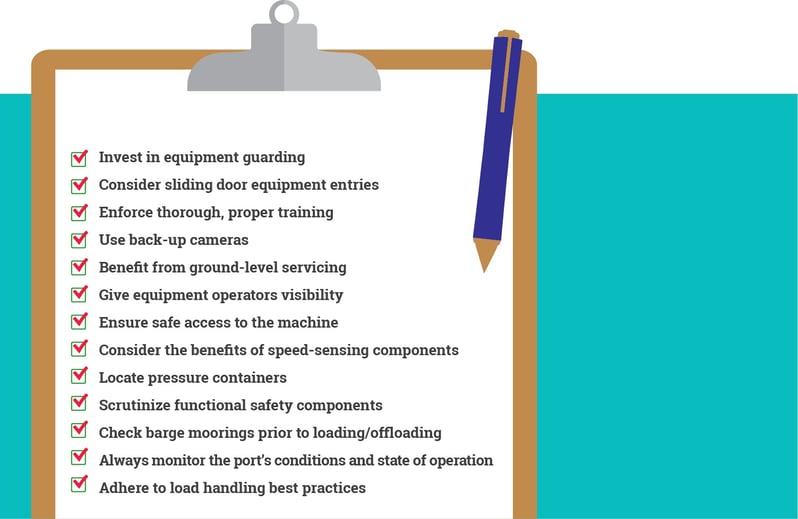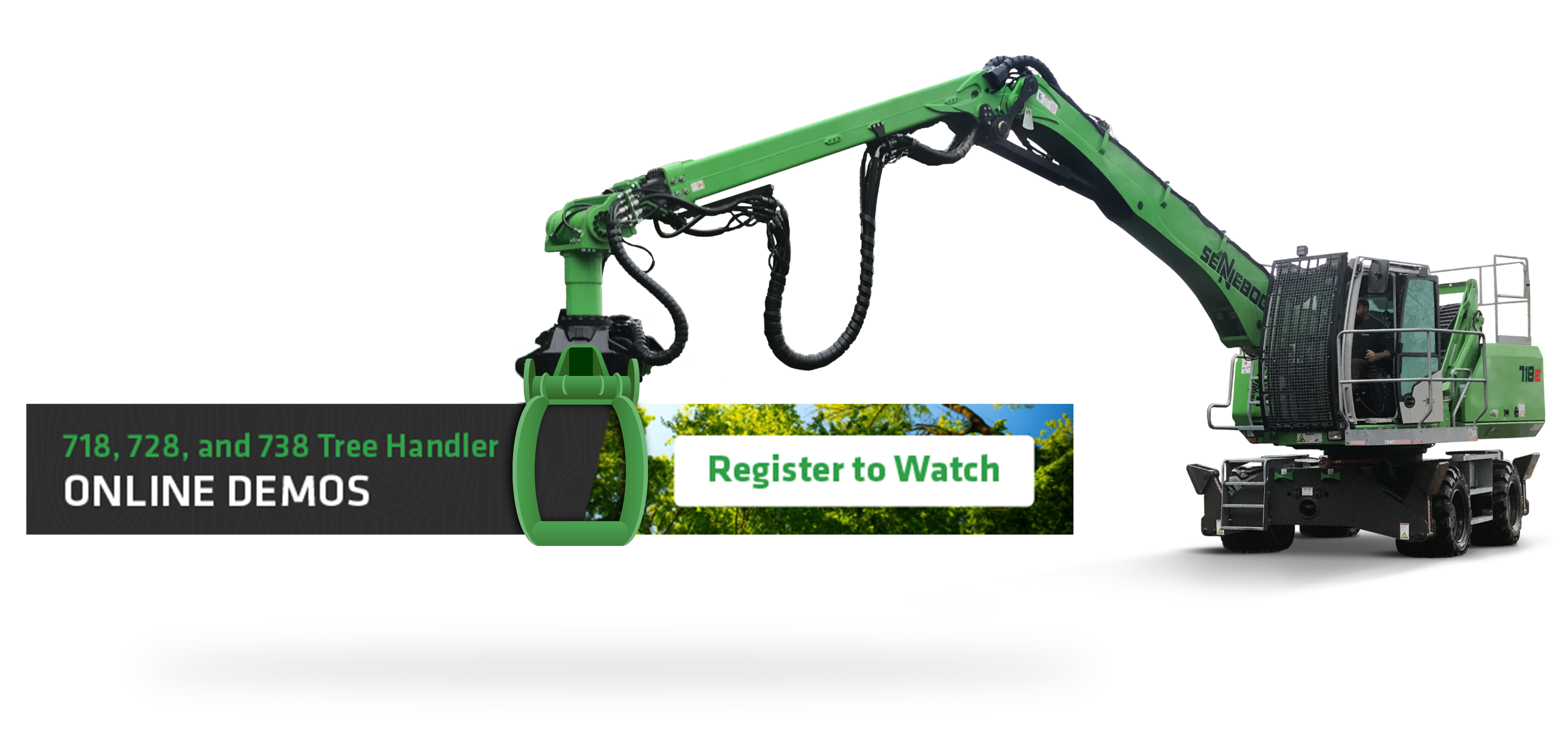As a port manager, you oversee many disparate business activities every day. In a high-risk environment such as a port, worker safety programs play an important role in daily operations. Those who work around heavy equipment face an increased risk of accident and injury. On-the-job injuries can lead to regulatory investigations, workers’ compensation claims, and the temporary or permanent loss of a valued worker.
The next time you review safety guidelines, compare your current equipment safety checklists with ours. We compiled our list of equipment-specific safety tips to maximize operational safety without sacrificing productivity or profitability.

- Invest in equipment guarding
- Consider sliding door equipment entries
- Enforce thorough, proper training
- Use back-up cameras
- Benefit from ground-level servicing
- Give equipment operators visibility
- Ensure safe access to the machine
- Consider the benefits of speed-sensing components
- Locate pressure containers
- Scrutinize functional safety components
- Check barge moorings prior to loading/offloading
- Always monitor the port’s conditions and state of operation
- Adhere to load handling best practices
- Invest in equipment guarding. Equipment guarding comes in many forms but performs the same function – to protect operators from harm. Guarding packages may reinforce glass windows for impact protection and prevent passersby from coming into contact with dangerous equipment components. Appropriate equipment guarding meets regulatory standards for performance. Consider equipment guarding as a simple and effective solution for employee safety in a port environment.
- Consider sliding door equipment entries. At first, the door configuration of the machine cab may not come to mind during a safety audit. In practice, sliding doors streamline the entry and exit process for improved safety. Swinging doors inhibit those standing on the platform from easily accessing the cab. The space saving and user-friendly feature minimizes accidents involving cab entry and exiting.
- Enforce thorough, proper training. Heavy equipment such as material handlers and cranes require skilled operation. Those who work in and around heavy port equipment should go through extensive training to understand both the magnitude of risk and the best practices that can reduce the likelihood of injuries.
Consider partnering with equipment manufacturers that provide free technical training to equipment users. Highly trained operators will develop a better understanding of machinery handling, the most common risks associated with usage, and how to troubleshoot equipment issues that increase safety risks and lower productivity rates.
- Use back-up cameras. Camera technology improves safety for all mobile equipment, from passenger vehicles to heavy-duty material handlers and trailer-pullers. Backup camera displays eliminate blind spots and give equipment operators the ability to manipulate heavy equipment with confidence. An operator who can quickly react in back and forth activities can use a backup camera to increase productivity without sacrificing safety.
- Benefit from ground-level servicing. Have you ever seen a machine operator or mechanic perched precariously near the top of a piece of heavy equipment? One false move stands between the person and a potentially serious injury. Equipment developed for ground-level servicing eliminates the need for uncomfortable – and potentially dangerous – servicing positions. The next time you purchase port equipment, look for a manufacturer that offers low level servicing for safety and peace of mind.
- Give equipment operators visibility. An equipment operator shouldn’t have to rely on cameras and small windows to navigate through the premises or operate a boom. Panoramic safety glass on three sides and floor windows increase operator visibility for improved reaction times and safety.
- Ensure safe access to the machine. As a Port manager in a port environment, you know machine operators often work for several hours at great heights. They may need the ability to lower the cab to ground level or to access an intermediate platform to reach the cab. Ensure each piece of heavy-duty equipment offers operators safe passage from the ground to the cab. Circular galleries, nonslip stairs, and railings improve visibility, accessibility, and safety at any height.
- Consider the benefits of speed-sensing components. Manufacturers can install and set speed-sensing and regulating components within heavy equipment to identify and control operating speeds before they turn into safety hazards. Depending on the setup, the components may impact a machine’s speed of travel, lifting/movement operations, or internal processes. The technology effectively creates a failsafe in the event of an emergency.
- Locate pressure containers. Machines featuring hydraulics also contain pressure containers. The location of the pressure container could represent a safety hazard to operators and equipment components. One of the safest places for pressure containers is near the rear of the machine. Consider the safety implications of container location before investing in a new piece of heavy machinery.
- Scrutinize functional safety components. Port equipment hydraulic and boom components should all meet safety standards to provide functional safety during operation. Beyond safety considerations, highly tested components may improve usability and increase loading/offloading times.
All lifting equipment and loose gear should be regularly inspected before and during use by trained and responsible personnel, with a purpose to check for obvious deterioration and determine whether they are safe for continued use. It is recommended that all lifting equipment should be inspected at the beginning of each shift or working day and once a week when in use.
Inspection should be carried out on emergency equipment and personal protective equipment, as well as operational plant and equipment. It’s been shown that regular inspections and reports on the conditions of ships help reduce the number of shipboard accidents involving port workers.
- Check barge moorings prior to loading/offloading. An equipment operator can only accomplish so much from inside the cab of the machine. An improperly moored vessel represents a hazard to anyone in the area during the loading and offloading process. Protect the cargo and nearby workers with safe equipment placement and barge mooring practices.
- Always monitor the port’s conditions and state of operation. As a port manager, monitoring is an extremely important aspect of managing safety. Without effective monitoring to compare “how it should be done” against “how it’s actually done”, long-term success is not likely. Monitoring can point out areas that need more attention.
Periodically review company procedures, safety regulations, and emergency procedures for fire, medical, and hazardous materials incidents. In case those conditions ever arise, your employees will know exactly what to do to avoid accidents and or injuries.
- Adhere to load handling best practices. While operating heavy equipment, operators should always adhere to certain best practices. For example, operators carrying loads should go forward on up ramps and in reverse on down ramps. To maintain stability and control, operators should raise and lower loads only from a stationary position. They should never exceed load limits and should adhere to all pre-operating checklists. Port managers who strictly enforce equipment handling best practices protect the people working in the area, the cargo in transit, and the equipment used.
Equipment safety plays a major role in overall port management and safety. When it comes to safety, compile all the regulatory requirements, industry best practices, and industry insights you can find into a comprehensive list designed with your port’s needs in mind.
Want to learn more about port management best practices? Download our eBook on optimizing port management efficiency today.
Sources:
http://sennebogen-na.com/wp-content/uploads/2015/09/Ports_Industry_Brochure.pdf
https://www.constructionequipment.com/material-handling-demands-safety-first
http://www.fleetmanagementweekly.com/10-tips-for-safe-use-of-material-handling-equipment/


.jpg?width=512&height=399&name=unnamed%20(94).jpg)
